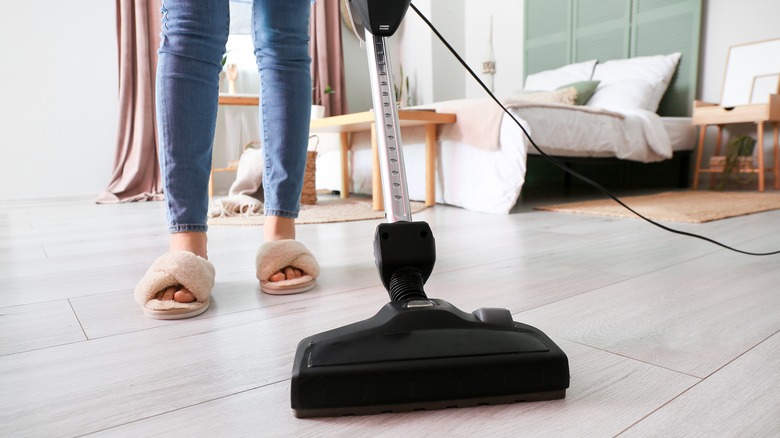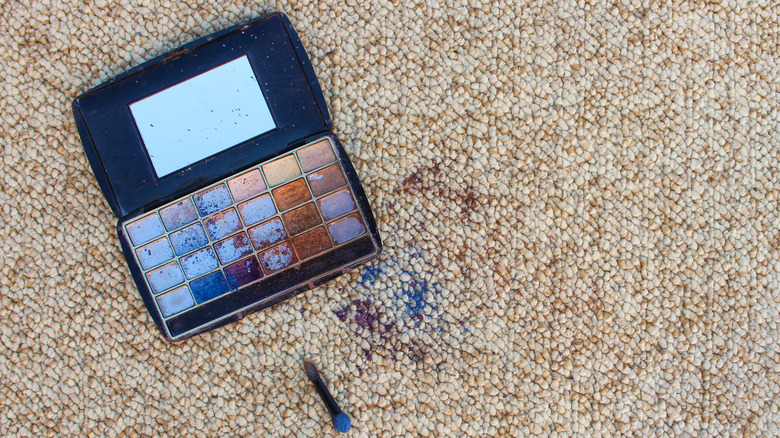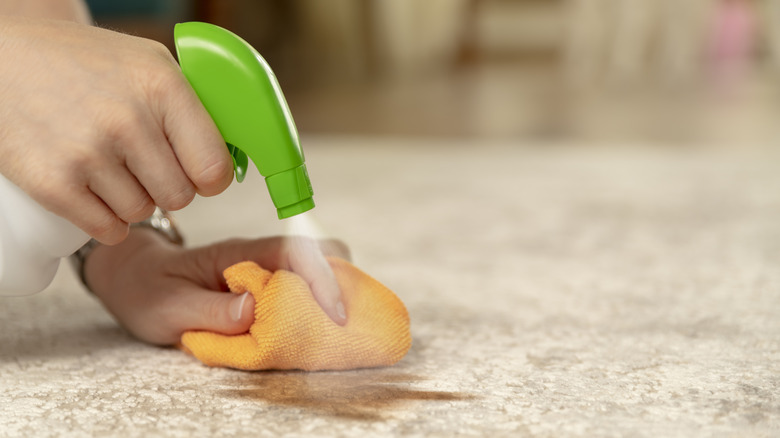Why You Might Want To Think Twice Before Vacuuming Around Your Vanity
The vanity, whether placed in your bedroom, walk-in closet, or other unused space, is likely where you spend minutes to hours on end getting ready for work, date nights, or a good night's rest. A popular place to put on makeup, style hair, and round out your beauty routine, a personal vanity is also a hotspot for messes, given the wide variety of cosmetics and skincare products regularly applied and stored within its many compartments. No matter how carefully you try to apply your makeup while sitting at your vanity, accidents are almost guaranteed and can range from small smudges to large spills that can be difficult to extract in the aftermath.
Before you start viciously scrubbing away at a lingering foundation stain or grab your vacuum to finish the job in a single swoop, understand the repercussions of vacuuming a floor littered with cosmetic fallout, both seen and unseen. Avoid vacuuming too close to your vanity in general, since any remnants of makeup scattered across the floor can destroy your vacuum and risk deepening any existing stains.
Even if no liquid or powder cosmetic residue is visible, there's still a chance substances are present somewhere along your floor. Using a vacuum is certainly a quicker solution to an annoying problem, but it's not worth the risk of ruining your machine or tarnishing your carpet. Here's more on why makeup spills and your vacuum don't mix, and how to go about spot-treating makeup stains instead.
Makeup harms your vacuum cleaner
The main issue that arises from relying on a vacuum cleaner to remove makeup stains is the increased chance of setting existing stains rather than eliminating them. The bristles located on the bottom of the machine extract dirt in hard-to-reach places along your carpet to achieve a deep and thorough clean, but these same bristles may cause more harm than good when used on cosmetic spills. Running a vacuum over a fresh stain can push the substance deeper into your carpet, making the blemish nearly impossible to remove after the machine's heat helps set the stain permanently.
It's also important to consider that many makeup products come in liquid form or, at the very least, have a consistency that easily melts after coming into contact with heat. This raises additional concerns regarding the safety of using a vacuum to extract makeup spills. Aside from the more versatile wet-dry models available today, many vacuum cleaners aren't designed to handle wet messes around the house since absorbing liquids can damage the machine's parts, particularly its motor. The vacuum bag, which captures and holds the machine's dirt until emptied, may also suffer damage when attempting to vacuum wet or dry cosmetics and will most likely need to be replaced when the time comes to use your vacuum again. In the absolute worst cases, you could damage your vacuum cleaner beyond repair, leaving you no choice but to find a replacement.
How to clean around your vanity
Because makeup products are so diverse in consistency, there's no single correct method to clean your floors after a spill. The cleaning products you should use and the order in which you should use them depend on the cosmetic product responsible for the mess. But as a common rule of thumb, always attempt to lift the stain to the best of your ability before running a vacuum over your floor.
To do this, first remove any remnants of the bare product left on the floor from the spill using a thin tool that's easy to maneuver, like a butter knife. Next, gather the materials you'll need to spot-treat your floors, which may differ depending on the type of cosmetics you'll be cleaning up. When removing foundation from carpet, use a solution of cold water and liquid dish soap to dab away the remaining stain. Try a mixture of warm water and vinegar when working with an eyeliner stain, and a drop or two of hydrogen peroxide to eliminate oil-based messes like eyeshadow stains. Once the stain is completely removed, go back over the spot with water and a microfiber cloth to prevent chemicals from drying on your floor.
Finally, use a vacuum cleaner to re-fluff any fibers that may have been matted by water or cleaning products. Make sure the carpet underneath is completely dry before going over it with a vacuum, as wet substances can lead to technical issues with your machine.


